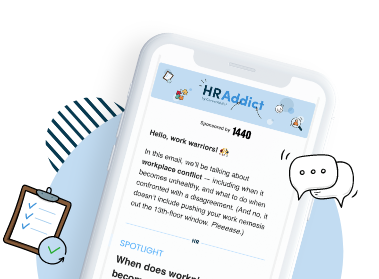This guest post is written by Rebecca Barnatt-Smith from Solvid UK.
An era of workplace dissatisfaction is on the rise. About 36% of employees across the U.S. and Europe are not satisfied with their current employer, with employee engagement in the U.S. reaching a 10-year low in 2024.
With many lacking enthusiasm for their duties, and almost all respondents noting that they’re actively disengaged from their responsibilities, it’s no surprise that turnover remains the number one challenge in the workforce.
The question is, how do you address the workplace dissatisfaction epidemic before it’s too late?
TABLE OF CONTENTS
Identifying the signs of unhappiness
Here are five metrics to start tracking if you want to identify signs of employee unhappiness and take proactive steps to improve satisfaction in the workplace:
1. Absenteeism
If your employees are frequently absent from the workplace, this could be a sign that they're unhappy in their role. Frequent absences from work, especially without a valid reason, are often a result of stress, burnout, and disengagement from responsibilities.
Investing in HR Software that tracks absenteeism can help you identify faster if an employee is unhappy in the workplace. If a worker has an unusually high level of absences in a short period or on specific days of the week, these insights could indicate that they’re struggling, disengaged, or finding new pattern shifts more challenging.
2. Employee turnover
One of the key signals that your employees are unhappy in the workplace is a high turnover rate. High turnover rates could stem from a variety of factors. These include poor team communication, lack of proper management, little to no opportunities for growth and development, or simply an unhealthy work culture.
As the world embraces the WFH era, it’s essential to get on top of your workplace satisfaction before it’s too late. Start by holding regular one-on-ones with struggling employees and investing time in developing the entire team.
Hotel group Travelodge, for example, identified that manager relationships and career progression were key factors in turnover, especially for part-time staff. Taking time to revamp their management strategies and expand career development programs based on employee feedback, they successfully spotted and addressed turnover risks, leading to improved employee engagement.
3. Productivity decline
Another metric to track is productivity decline. If you notice a significant drop in an employee’s attitude toward their work, it could be a sign that they’re disengaged from their role.
In an era of quiet quitting, productivity dips are the most common challenges companies face when they fail to address issues in their work culture. When employees are unhappy, they lack motivation for their responsibilities and lose focus in the workplace. This can lead to costly errors, deadline extensions, and a decrease in overall output.
4. Decline in engagement rate
Gallup’s State of the Global Workplace 2025 report shows that global employee engagement declined to 21% in 2024. While it’s a more complex metric to track, employee engagement insights can tell you a thousand words about how your worker feels about their position in the company. You can measure employee engagement through feedback surveys, channel communication, and the quality of work turned in.
The benefits of investing in employee engagement outweigh the costs. There are also plenty of ways to get creative with your employee engagement strategy.
Take tech giant Google, for example. Google invests in employee engagement by allowing each and every worker to dedicate 20% of their work time to passion projects. This initiative that aims to spark creativity and innovation has helped re-engage employees with their role. Did you know the passion project initiative has since led to famous innovations like Gmail and Google Maps?
5. Negative attitude and behavior
Last but not least, take a look at your employee’s attitude and behavior in the workplace. This metric focuses less on data and more on an employee’s general demeanor from day to day.
Track patterns of negative speaking about the company, grumbling, or a lack of enthusiasm when they interact with other colleagues. These behavioral changes could indicate that a worker feels unhappy in the workplace. If your team is primarily social, take note of the employees who always fail to turn up to social activities and begin to take less interest in maintaining work relationships.
Fostering a happy workforce: 3 tips to remember
Once you’ve started tracking your workplace satisfaction levels, you must intervene early to avoid a rise in employee turnover. Let’s take a closer look at some of the best ways to improve employee engagement and turn your workplace culture around.
Invest in mental health and wellbeing support
Workplace-based stress and burnout are at an all-time high at 66% in 2025, and they’re the primary drivers of absenteeism and employee turnover. To combat this, aim to provide comprehensive mental health support for your employees.
If you want to build a resilient workforce, taking time to invest in their mental health is a vital first step. This includes providing access to support networks, helpful resources, and most importantly, improving workplace culture.
Try introducing more team activities to strengthen collaboration. If you have a larger budget, also consider offering flexible working arrangements, wellness days, and wellbeing budgets for activities like fitness or therapy.
Prioritize career development pathways
Lack of development opportunities is the leading cause of employee turnover. Employees want to feel that they have space to grow in a company. This means investing in development pathways, providing regular training, and offering frequent feedback on a worker’s growth.
If your employees see you investing in their long-term growth, they'll think twice about leaving the company.
Cultivate a culture of belonging and recognition
If an employee feels valued in the workplace, they’re more likely to contribute and be engaged in their role.
The key is to foster an inclusive culture in the workplace that brings employees together. Building relationships through team-building exercises, regular wellbeing workshops, and frequent check-ins is a brilliant way to encourage workers to speak freely about their feelings at work.
To take this a step further, team leaders should aim to cultivate a sense of belonging for every employee. Making it a point to recognize achievements, even small milestones, is a great place to start. Why not encourage peer-to-peer praise? This is a great way to strengthen bonds within the team itself.
A happier, healthier workforce
An unhappy workforce is an unproductive workforce. Maintaining workplace satisfaction is paramount if you want to reduce turnover, absenteeism, and productivity dips.
The key here is to strike before it’s too late. Tracking metrics ahead of time makes it easy to spot disengagement early and intervene at the right time.

